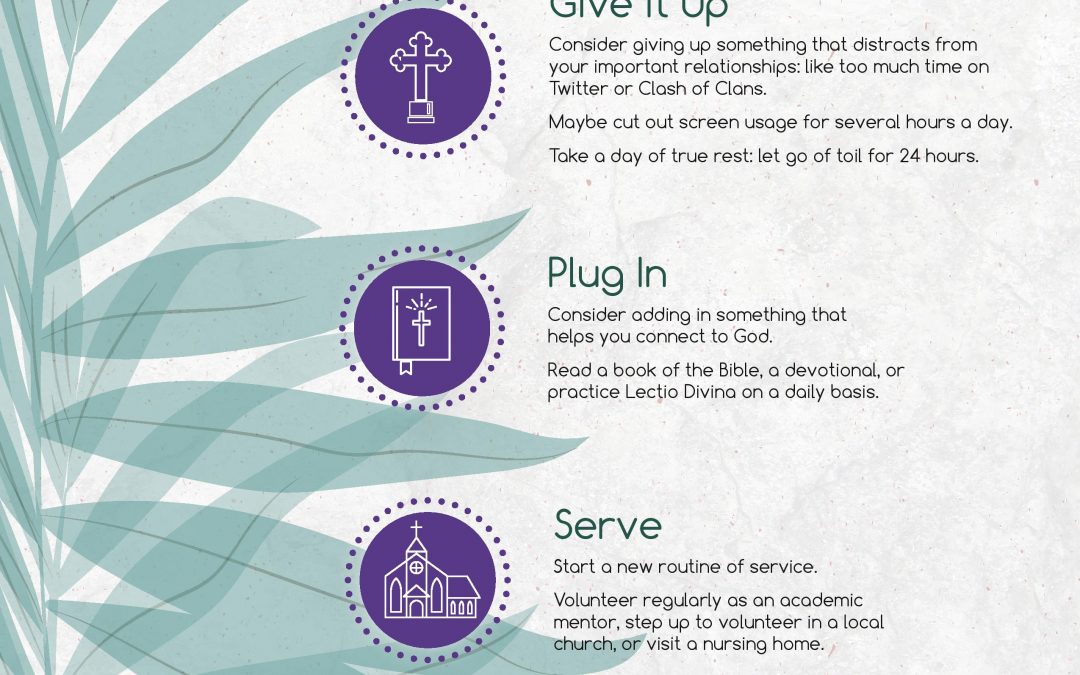Greetings, beloved ones!
And now it’s Lent.
As we begin this sacred season, I share the following from ResourceUMC:
Friday fish fries. No chocolate. Join a new Bible study.
All these practices have benefits. And all are common Lenten practices. They hint at ways the season of Lent can lead us into more disciplined, focused lives. With that in mind, we offer some other practices that hit at the heart of Lent and excite our spiritual lives.
Lent is the period of 40 days leading up to Easter (note: Sundays don’t count). It is a time of preparation and focus, reminiscent of Jesus’ time in the wilderness before he started his public ministry (See Mark 1, Matthew 4, or Luke 4).
We believe that Jesus went to the wilderness to set aside the distractions of normal, worldly” life and focus on God and God’s will for him. So we attempt to do the same during Lent – “enter the wilderness” and find some focus for our lives as well.
¬ Suggestions? See the graphic.
What is the spiritual discipline called Lectio Divina?
Lectio Divina − Latin for “Divine/Sacred Reading” − is a traditional monastic practice of Scriptural reading, meditation, and prayer intended to promote communion with God and to increase our experiential knowledge of God’s Word. I personally find this practice to be my favorite spiritual discipline.
Traditionally, there are five steps of Lectio Divina:
1. Silence. Breathe. Center down. Quiet your thoughts and allow yourself to enjoy the silence, as you prepare to read the Word of God.
2. Read the selected Scripture verse, passage, or Psalm a total of three times – slowly – and, if possible, out loud. Why? Reading out loud slows down your natural inclination to breeze through the Scripture. In the second and third readings, details, words, and insights that are completely missed in the first reading will stand out as though in bold print and seem to jump off the page.
3. Meditate on what you’ve read. Actively. Circle verbs and nouns with an eye for patterns and metaphors that provide a deeper meaning to God’s Word. Take your time. Continue to breathe.
4. Conversation with God. Now turn to God, not only with your own thoughts but with an insight into God’s thoughts and wisdom. Your one-sided thoughts can now become a two-sided conversation where you experience God’s guidance, consolation, and grace.
5. Contemplation. “Be still and know that I am God.” Here, take a moment to rest in God’s presence and experience the love and insights you have gained from reading and prayer.
From here, you will be called to put your faith into action.
− Five Steps adapted from Suzanne Elizabeth Anderson
From Coralee:
If you aren’t already practicing Lectio Divina, I invite (urge) you to begin by reading “The Healing of Blind Bartimaeus” as recorded in Mark 10:46-52.
First, read the passage slowly to “get there.” What emotions, sights, sounds, smells etc. do you experience as you observe the scene?
During your second reading, put yourself in the crowd – you are one of those who sternly ordered Bartimaeus to be quiet! You shouted at him, “Shut up!” Your experience of this role?
Throughout your third reading, you are Bartimaeus. You are the poor, blind beggar sitting by the roadside, screaming for help. Read slowly. Let his prayer become yours. “Jesus, Son of David, have mercy on me!”
Close your quiet time with grateful prayer. Thank Jesus for His stopping and “standing still” to hear your own prayers, meeting you in your need, and working His work for good in your life. Then, go on to “follow Him on the way.” Amen.

